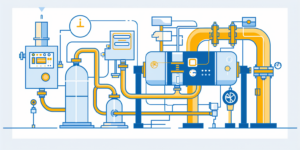Alaska summers may be short, but long days bring plenty of sunshine. With over 19 hours of daylight, the sun has plenty of time to warm up our living areas. That warmth can stick around into the evening, making it harder to cool down and relax. You don’t need extreme solutions, just a few smart moves to keep cool in Alaska.
Simple Strategies to Keep Cool Naturally
With long daylight hours and short nights, things can heat up quickly. These natural cooling strategies reduce indoor temperatures and improve airflow without relying heavily on mechanical systems.
Ventilation That Works With the Weather
Take advantage of Alaska’s cool nights and fresh air to manage indoor temperatures naturally. Smart ventilation can still make a big difference, especially during long daylight hours.
- Create cross-breezes by opening windows on opposite sides of the house
- Close windows and draw blinds by mid-morning to block out solar gain
- Use kitchen and bathroom exhaust fans to remove warm, humid air
- Keep interior doors open to improve airflow
- Set ceiling fans to spin counterclockwise in summer to push cooler air down
- Place box or oscillating fans near windows or hallways to move air where it’s needed
Reduce Solar Heat Gain Indoors
Direct sunlight can quickly raise indoor temperatures significantly. Block it with thermal or blackout curtains and apply reflective window film to bounce heat away.
Improve insulation in walls and attics to keep indoor temperatures steady. Seal gaps around windows and doors to prevent warm air from leaking in.
Small upgrades like these, combined with smart ventilation, help you stay cooler all summer.
Targeted Cooling with Ductless Mini Splits for Any Room
When natural airflow falls short, ductless mini splits offer a flexible, efficient way to cool specific areas. They’re a great fit for Alaska’s unique climate, especially where full HVAC systems aren’t practical. Whether it’s a stuffy upstairs bedroom or a sun-soaked living room, mini splits improve energy efficiency and give you room-by-room control without the need for a major renovation.
Here are some of the most common spaces where mini splits are a wise choice:
- Cabins or second residences without existing ductwork
- Upstairs bedrooms that get warmer than the rest of the house
- Bonus rooms, basements, garages, or workshops
- Home additions or areas with uneven temperatures
These systems offer flexible, year-round temperature control without the cost or disruption of a full HVAC install.
Stay Comfortable All Year with an Energy Efficient Heat Pump
Modern heat pumps are built for cold climates and work well in Alaska. They cool in summer, heat in winter, and offer a simple all-in-one solution year-round.
Heat Pumps vs. Traditional HVAC
Heat pumps heat and cool using one system, making them simpler and more versatile than traditional HVAC setups. Cold-climate models work reliably even below freezing, which makes them well-suited for Alaska homes.
The Long-Term Value of Efficiency
Heat pumps use less energy, because they move heat instead of generating it. They reduce utility bills, require less maintenance, and may qualify for energy rebates.
Why Heat Pumps Make Sense in Alaska
Alaska residences come in all shapes and sizes, and so do their heating needs. Heat pumps offer a flexible solution that works well in a wide range of living spaces. Here are a few reasons why many people choose them:
They’re ideal for properties that rely on electric baseboard systems. Adding a heat pump can significantly reduce electricity use while still providing both heating and cooling from one system.
They help balance uneven temperatures throughout your living space. They’re a smart solution for areas that are too hot in summer or too cold in winter, like upstairs bedrooms, sunrooms, or basements.
They pair easily with existing systems. You don’t have to replace your whole setup — heat pumps can supplement wood stoves or other primary heat sources for added efficiency.
What’s the Difference Between Heat Pumps and Mini Splits?
It’s easy to confuse these two systems, especially since they’re both efficient and used in similar ways. The short answer: mini splits are a type of heat pump, but not all heat pumps are mini splits. Here’s how they compare:
| Feature | Heat Pump | Mini Split |
|---|---|---|
| Function | Heats and cools | Heats and cools |
| Ductwork Required | Sometimes (ducted or ductless models) | No |
| Best For | Whole-home systems or hybrid setups | Zoned comfort in specific rooms |
| Installation Style | Can be central or room-based | Always room-based with wall units |
| Common in Alaska? | Increasingly, yes | Very popular for additions and upgrades |
Staying Cool Alaska Style
You don’t need extreme central air conditioning to stay comfortable in the summer. A few smart habits that are paired with the right system in the right space can make all the difference.
Living Waters offers HVAC maintenance, system upgrades, and energy-efficient installations designed for Alaska homes. Whether you need a tune-up, a mini split, or a cold-climate heat pump, we’re here to help you stay cool without going overboard.
If you’re not sure if a mini split is right for you, let’s talk. We’ll give you honest advice, not a sales pitch. Contact us today.


